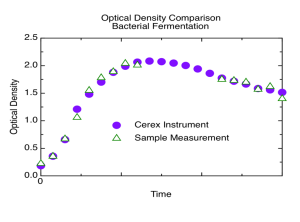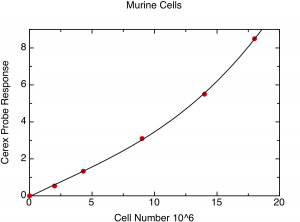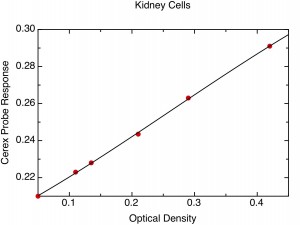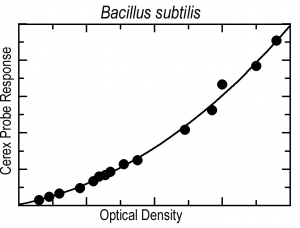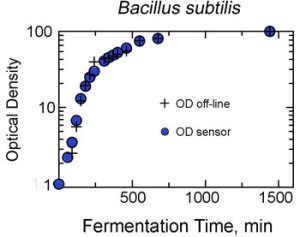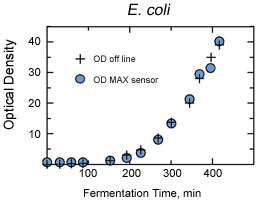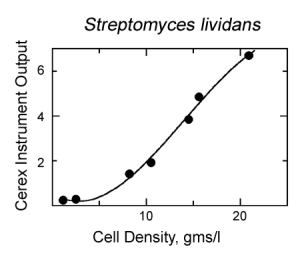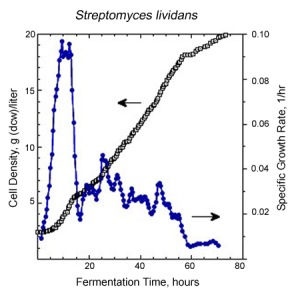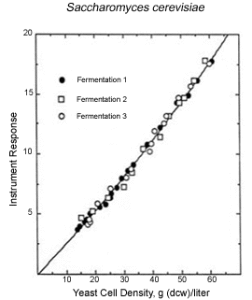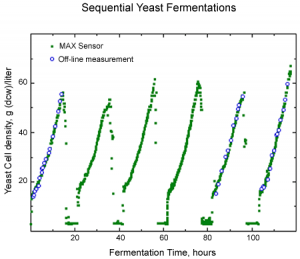Excelling instrument performance
MAX can collect cell mass concentration measurements around-the-clock and transmit the information on-line to a supervisory controller/computer. Parameters such as pH, dissolved oxygen, aeration, agitation, nutrient addition, and harvest cycles can all be controlled based on cell mass concentration. The system automatically determines and displays specific growth rate for both current values and specified time intervals at any time interval in the process. Mid-log and stationary phase points can be determined, providing a powerful tool for continuous culture and fed-batch steady-state control. For the production of proteins using recombinant DNA, induction timing can be made with precision and enhance batch to batch consistency.
With MAX’s ability to provide on-line cell mass measurement, kinetic growth experiments can be infinitely varied in a single fermentation run, resulting in fewer required experiments. This translates to faster turnaround, reduced equipment requirements, and more reliable data.
- The MAX sensor is in use for a range of fermentation microorganisms and animal cell types
- The MAX sensor is used for both low and high cell densities with optical densities ranging from less than 1 to greater than 100
- The MAX instrumentation can be directly coupled to user’s instrumentation and computers for on line monitoring and control through both analog outputs (4-20mA and 0-5v) and the serial port RS232
- Our MAX instrument calculates specific growth rate on line from the OD data. The specific growth rate is output to the display as well as to the user’s instrumentation
Animal Cells
- MAX sensor is calibrated against off line measurements of animal cells in culture
- A smooth calibration curve is shown for both cell types
- Good results are achieved for low optical densities
Bacillus
- MAX sensor is calibrated against off line measurements of optical density
- A smooth calibration curve is shown
- The optical density of a Bacillus subtilis fermentation is followed by both the MAX sensor and off-line measurements
- As shown both off-line and the MAX sensor give consistent results over the course of the fermentation
- E. coli
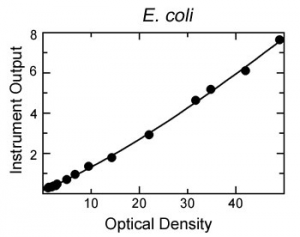 The MAX sensor is calibrated against off-line optical density measurements
The MAX sensor is calibrated against off-line optical density measurements - A smooth calibration curve is shown
- The optical density of an E. coli fermentation is followed by both the MAX sensor and off-line measurements
- The off-line measurement and the MAX sensor give consistent results over the time course of the fermentation
Streptomyces
- MAX sensor is calibrated against off line measurements of cell dry weight
- A smooth calibration curve is shown
- Streptomyces lividans was grown to a cell density of 20 grams dry cell weight/liter over 70 hours.
- Upon calibration for dry weight, the MAX sensor is able to provide semi continuous readings of cell density starting with the inoculation cell density of 2.5 g/l.
- The MAX instrument also calculates the specific growth rate over the course of the fermentation.
Yeast
- MAX sensor is calibrated against off line measurements of cell yeast dry cell weight
- A smooth calibration curve is shown over multiple fermentations for yeast dry cell weights up to 60 grams/liter
- The output from the MAX instrument is plotted along with off-line measurements on a PC as shown.
- Saccharomyces cerevisea was grown in sequential fed batch cultures to cell densities of 55 to 65 grams dry weight/liter.
- Upon calibration for dry weight, the MAX sensor is able to provide accurate semi continuous readings of cell density.
Specific Growth Rate
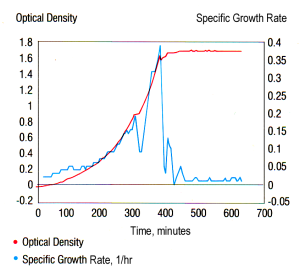 The MAX sensor can detect rapid changes in the specific growth rate of the culture. The MAX instrument continuously calculates optical density and specific growth rate for display and output to the host computer.
The MAX sensor can detect rapid changes in the specific growth rate of the culture. The MAX instrument continuously calculates optical density and specific growth rate for display and output to the host computer.
This figure shows data from an E. coli fermentation in which the specific growth rate was calculated by the MAX instrument. At mid-log growth the culture was induced by increasing the temperature. This caused a decrease in the specific growth rate for approximately 15 minutes while the organism adjusted to the new conditions.
Need more information or a quotation? Contact Us.

